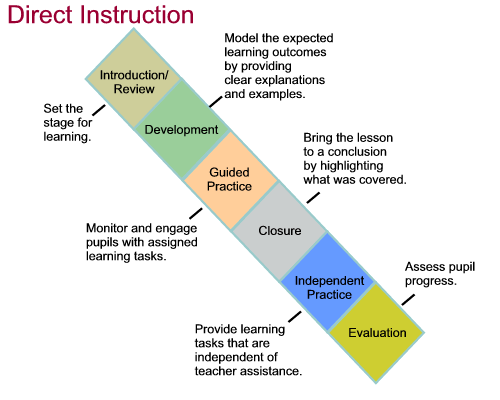
What is Direct Instruction?

Direct Instruction Learning Visual Concept Diagram
Description
Based on Zig Engelmann's theory of instruction, DI is probably the most popular teaching strategy that is used by teachers to facilitate learning. It is teacher directed and follows a definite structure with specific steps to guide pupils toward achieving clearly defined learning outcomes. The teacher maintains the locus of control over the instructional process and monitors pupils' learning throughout the process. Benefits of direct instruction include delivering large amounts of information in a timely manner. Also, because this model is teacher directed, it lends itself to designing instruction that is developmentally appropriate to pupils' ages and stages.
Principles of Direct Instruction
The most commonly used principles include:
Introduction/Review
Topics or information to be learned is presented to the pupils or review of information sets the stage for learning.
Development
The teacher provides clear explanations, descriptions, examples, or models of what is to be learned while checking for pupils' understanding through questioning.Guided Practice
Opportunities are provided to the pupils to practice what is expected to be learned while the teacher monitors the activities or tasks assigned.
Closure
Teachers conclude the lesson by wrapping up what was covered.
Independent Practice
Assignments are given to reinforce the learning without teacher assistance.
Evaluation
Assessment of pupil progress is conducted to determine levels of mastery.
Procedures
- Introduction/Review
The first step in DI is for the teacher to gain the pupils' attention. Sometimes this step is referred to a 'focusing event' and is meant to set the stage for learning to take place. At this stage, the pupils are 'informed' as to what the learning goal or outcome is for the lesson and why it is important or relevant. This step can either take the form of introducing new information or building upon what has been previously learned or covered as a review. - Development
Once the goal is communicated to pupils, the teacher models the behavior (knowledge or skill) that pupils are ultimately expected to demonstrate. This step includes clear explanations of any information with as many examples as needed to assure pupils' understanding (depending on pupils' learning needs) of what is to be learned. During this step, the teacher also "checks for understanding" by asking key questions relative to what is to be learned or by eliciting questions from pupils. At this stage, teachers can also use 'prompts' (visual aids, multimedia presentations, etc.) to encourage pupils to process information successfully. - Guided Practice
Once the teacher is confident that enough appropriate examples and explanation of the material to be learned has been modeled with sufficient positive pupil response to the instruction, activities or tasks can be assigned for pupils to practice the expected learning with close teacher monitoring. It is at this stage that teachers can offer assistance to pupils who have not yet mastered the material and who may need more 'direct instruction' from the teacher (step 2 repeated). - Closure
As a final step to this model, closure brings the whole lesson to a 'conclusion' and allows the teacher to recap what was covered in the lesson. It is meant to remind pupils about what the goal for instruction was and for preparing them to complete the independent practice activities that are then assigned by the teacher. - Independent Practice
Activities or tasks related to the defined learning outcomes are assigned in this step usually after pupils have demonstrated competency or proficiency in the 3rd step. Independent practice is meant to eliminate any prompts from the teacher and is meant to determine the degree of mastery that pupils have achieved. (Homework can be classified as an independent practice because it is meant to provide the opportunity for pupils to practice without the assistance or help from the classroom teacher.) - Evaluation
Evaluation tools are used to assess pupils' progress either as it is occurring (worksheets, classroom assignments, etc.) or as a culminating event (tests, projects, etc.) to any given lesson. Evaluation of pupils' learning provides the necessary feedback to both the teacher and the pupil and can be used to determine whether expected learning outcomes have been met or have to be revisited in future lessons.